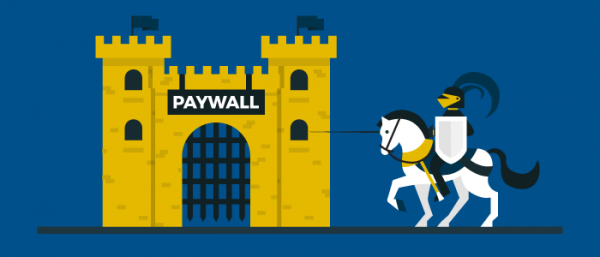
The paywall model isn’t an SEO-killer, even though it’s been billed as one. Technology has advanced a long way since the days when content was either locked, or unlocked. Firstly, there are two types, a hard paywall, and a soft paywall (and varying degrees in between):
A hard paywall requires users to pay to access all content. There is no content available to read without registering first, whether registration is free or paid. SEO, as you might imagine, is poor for sites that have hard paywalls. Some circumvent this issue by giving away at least 300 words of each article before the call-to-action which suggests the subscribe. However, news organizations aren’t known for their search optimization savvy, so we generally don’t see a hard paywall as an SEO-friendly option, and they’re often done poorly.
A soft paywall, which is typically a metered paywall, may come in different levels of “softness” but refers to content that may be accessed up until a point. For example, a reader may get three articles for free before they are asked to subscribe.
[text_ad]
 Metered paywalls have a proven track record of conversions, and for the niche publishers we work with, we develop paywalled content as an entirely separate business model, where the content is served through your magazine subscription website, and where free content exists on your main Portal. To the visual eye, this is probably the difference between two tabs in your website navigation, but because they produce revenue differently, we separate the two fundamentally.
Metered paywalls have a proven track record of conversions, and for the niche publishers we work with, we develop paywalled content as an entirely separate business model, where the content is served through your magazine subscription website, and where free content exists on your main Portal. To the visual eye, this is probably the difference between two tabs in your website navigation, but because they produce revenue differently, we separate the two fundamentally.
Yankee magazines’ NewEngland.com is a great example of one of our clients using this method, along with their magazine subscription website. The metered paywall floaters you’ll find on NewEngland.com are designed to generate premium membership to Yankee magazine and library as part of a seamless process.
The Economist is an example of a hybrid. Even though they offer a few articles for free, they require registration first. They have taken the huge step of gathering a readers’ information upfront, but likely suffer from the average 15-20% retention rate of a hard paywall and sacrifice SEO opportunities in the meantime. To combat this, they follow our best practice of using their free website Portal to attract readers through free content, some of which was formerly printed in the magazine, and some that never makes it to the formal publication.
The Financial Times who has seen success with their paywall, had an interesting approach beginning in 2015, with a hard paywall that asked for just $1 for the first month, which auto-renewed the next month. This approach was to light a fire and start transforming reading habits.
There’s a lot more to transforming reading habits than subscribing, though. How many times have you paid for a gym membership, which is auto-debited from your bank account, and stopped showing up after the first couple of months, letting your card be billed again and again? It’s great for the gym, but how much were your habits actually transformed?
News organizations and the paywall model

The simple answer is yes they can, but if you have an effective plan for free evergreen content, or a 6- to 12-month content recycling plan that re-publishes old magazine content onto your free Portal, then they don’t need to.
Niche publishers in consumer categories like gardening, ceramics, or even travel, have no trouble re-purposing magazine content, optimizing it for search, and publishing it later on for free.
News organizations, on the other hand, cease to exist if they don’t share the news online immediately. They also require a constant feed of traffic so they can either generate revenue through advertisers, or through paid content.
So while niche publishers have a variety of premium evergreen products like magazines, books, online courses, and so on, a news organization can’t afford to hold back the “best” content for a printed publication, or wait to give access at a pre-determined time during the month. That’s where the need for a paywall came in.
Also, there’s a “need” on the end of the consumer who wants to stay informed regularly. The paywall model has proven effective for news organizations because when they gate access, people feel they need to pay for it and they’re used to paying for news. They’re most likely to do this with the news organization they trust most. When it comes to news, those who are willing to pay for content, also have a preference on who the authority is reporting it.
There is still a huge segment of people who will never pay for the news. They’re OK with getting their news through limited-character bursts on Twitter and never clicking past the headlines. (Have you ever noticed these also seem to be the people with the loudest opinions? But I digress … .)
There are also in-betweeners who will read all the free news stories, but don’t have a morning routine of reading the news, and may not have a preference of where it comes from. If a newspaper was building a document of buyer personas, those would not be their target audience. It would be the news-devourers who have a preference of brand, who may buy a newspaper in print already, and who spend at least an hour reading the full-length articles every day.
For these consumers, the paywall model makes sense. Not to mention, news organizations don’t rely heavily on SEO for their traffic. That isn’t to say they shouldn’t. I’d be lying if I didn’t gasp the first time I saw the New York Times post a listicle, however we advise every publisher to create evergreen content, even news publishers so that you have some level of consistency in your organic traffic that you can count on, and which doesn’t lead to outdated, expired content.
The more page views, the better your advertisers will pay. So the dual-route of paywalls and free content for news organizations is a perfect fit, and publishers like the New York Times didn’t complain when revenue of paywall-induced subscribers surpassed advertising revenues.
Niche magazines and the paywall model

For niche magazines, we still believe premium content should be gated, whether by paywall, by magazine subscription website, or both. Your magazine content should not arrive for free on your website at the same time as your magazine is hitting newsstands or being delivered to paying subscribers.
We suggest at least a six-month delay between printed content, and when it hits your free website Portal. If your content is seasonal, you may even wait a full year to release it in the same season the following year.
In the meantime, your premium magazine content can still reap the benefits of SEO through a metered paywall. This model allows content to be read by consumers (and Google) but also enters readers into a subtle orderflow.
Telling a reader that they’ve already read three articles this month makes them think, “Oh wow, I’ve been to this site a lot this month.”
When you tell them the next time (whether they arrive through search or a Tweet or Facebook post) they see the paywall and think, “boy, I seem to keep arriving here, I must really like this content.”
And after they continue to hit the paywall, you’ve established in their mind that you’re an important resource to them. And if they want to stop hitting the wall, then they should subscribe. That language reminding them that they have already read three articles this month, acts as a trigger, making them aware of their loyalty to your publication.
Paywalls are certainly an open-ended discussion, but we find that you can hit two birds with one stone by pairing a free Portal with a magazine subscription website that leverages a metered paywall. What are your thoughts?
To discuss how we can help you use magazine subscription websites and subscription offer testing to grow your audience, revenue and profits, schedule a free introductory conversation today.



Fantastic insight into a gray methodology. It’s a tight balance between the free & paywalled content; one I struggle with as I develop my site. Not a Mequoda member (yet) but following much of the Mequoda Method, especially what you’ve described here. Specifically, my niche pub has short stories of varying length. The shortest are always free and account for about 10-15% of my total content. As the stories get longer, so do the subscription requirements. But, I also offer a free 2-week premium subscription, which gives anyone (including Google) access to everything, for a limited time.
At least that’s the plan. Still working out the technical side of a few things. Any recommendations for software/services to manage the metered paywall? Note, I’m not using WordPress. So far, the best I’ve found is GoPaywall. Simple set up.
Great article. Archiving it for later reread.